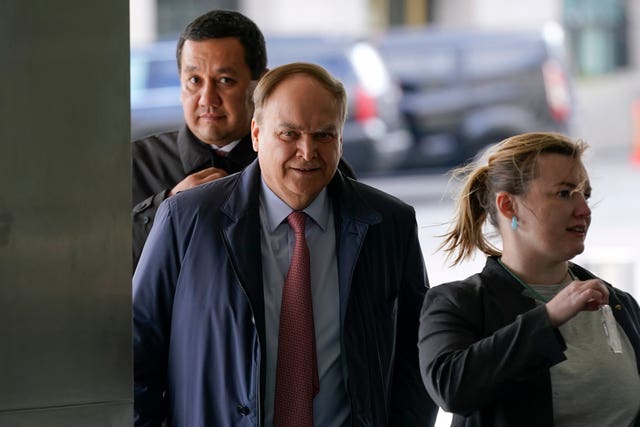US and Russia ratchet up rhetoric over downing of drone
The Kremlin said the incident proved direct US involvement in the Ukraine conflict while US officials said it showed Russia’s aggressive behaviour.

Russia and the United States have ratcheted up confrontational rhetoric over a US surveillance drone that encountered Russian warplanes and crashed near the Crimean Peninsula, while both countries pledged to try to avoid escalation.
The Kremlin said the incident proved again that Washington is directly involved in the fighting and added that Moscow would try to recover the wreckage of the drone from the Black Sea.
US officials said the incident showed Russia’s aggressive and risky behaviour and they pledged to continue their surveillance.
Russia has long voiced concern about US surveillance flights near its borders, but Tuesday’s incident signalled Moscow’s increasing readiness to raise the ante amid soaring tensions between the two nuclear powers.
Nikolai Patrushev, the secretary of Russia’s Security Council, said in televised remarks the drone incident was “another confirmation” of direct US involvement in the Ukraine conflict.
The Kremlin has repeatedly said the United States and other Nato members have become direct war participants by supplying weapons and intelligence to the Kyiv government and pressuring Ukraine not to negotiate peace.
Mr Patrushev, a close confidant of President Vladimir Putin, also said Russia planned to search for the drone’s debris.
A US official said it was unclear whether Washington would recover the fragments after securing the information it had gathered.
“I don’t know if we can recover them or not, but we will certainly have to do that, and we will deal with it,” Mr Patrushev said.
“I certainly hope for success.”
US National Security Council spokesperson John Kirby said the drone was in international airspace when a Russian fighter jet struck the propeller of the MQ-Reaper drone.
US officials accused Russia of trying to intercept the unmanned aerial vehicle, although its presence over the Black Sea was not uncommon.

Mr Kirby said the US “took steps to protect the information and to protect, to minimise any effort by anybody else to exploit that drone for useful content”.
Sergei Naryshkin, the head of Russia’s Foreign Intelligence Service, said Russia has the technological capability to recover the drone’s fragments.
Kremlin spokesman Dmitry Peskov repeated the Defence Ministry’s statement that Russian jets did not use their weapons or impact the US drone.
He repeated his description of US-Russia relations as at their lowest point but added that “Russia has never rejected a constructive dialogue, and it’s not rejecting it now”.
In Washington, Russian ambassador Anatoly Antonov expressed concern about “the unacceptable actions of the United States military in the close proximity to our borders”.
“What do they do thousands of miles away from the United States?” he said in remarks the Russian embassy released on Wednesday.
“The answer is obvious – they gather intelligence which is later used by the Kyiv regime to attack our armed forces and territory.”
“Let us ask a rhetorical question: If, for example, a Russian strike drone appeared near New York or San Francisco, how would the US Air Force and Navy react?” Mr Antonov wrote on the embassy’s Telegram channel.
“I am quite confident that the US military would act in an uncompromising way and would not allow its airspace or territorial waters to be breached.”
He noted that “it is important that the lines of communication should remain open”, emphasising that “Russia does not seek confrontation and stands for pragmatic co-operation in the interests of the peoples of our countries”.
US defence secretary Lloyd Austin said the Russian intercept was part of a “pattern of aggressive, risky and unsafe actions by Russian pilots in international airspace”.
He said Russia must operate its aircraft in a safe manner.

While encounters between Russian and Nato aircraft are not unusual – before the invasion of Ukraine, Nato planes were involved in an annual average of 400 intercepts with Russian planes – the war has heightened the significance and potential hazards of such incidents.
“The last thing that we want, certainly the last thing that anybody should want, is for this war in Ukraine to escalate to become something between the United States and Russia, to have this actually … expand beyond that,” Mr Kirby said, speaking on Wednesday on CNN.
“We’ve been working very, very hard throughout the beginning of this conflict … to make sure that it doesn’t escalate into, particularly into that area,” he added.
The secretary of Ukraine’s National Security and Defence Council, Oleksiy Danilov, tweeted the drone incident was “a signal from Putin that he is ready to expand the conflict zone, with drawing other parties in”.
Separately, the UK Ministry of Defence (MoD) said British and German air force fighter jets were scrambled on Tuesday to intercept a Russian aircraft near Estonian airspace.
The UK and Germany are conducting joint air policing missions in Estonia as part of Nato’s bolstering of its eastern flank.
The MoD said the Typhoon jets responded after a Russian air-to-air refuelling aircraft failed to communicate with Estonian air traffic control.
The Russian plane did not enter the airspace of Estonia, a Nato member.





